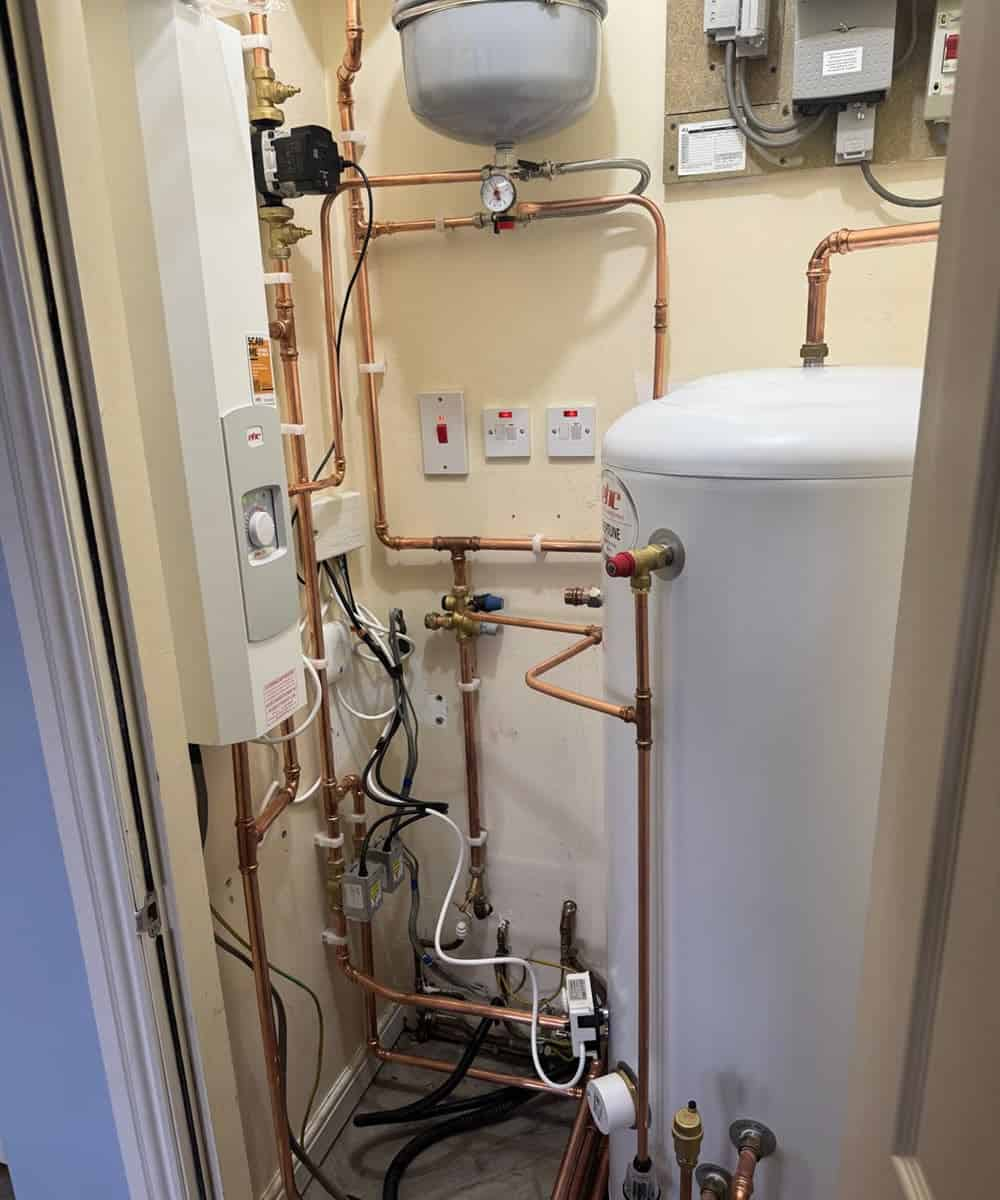We’ve recently been brought into two jobs where the homeowners and contractors hadn’t been aware of how easily a 60-amp main fuse can be overloaded causing blown fuses, power cuts, and stressful delays while waiting for re-connections. This can happen for various reasons but in the first case it was a new boiler tripping the main fuse, whereas in the second case the main fuse was being overloaded by an incorrectly configured renewables installation.
This article aims to raise awareness among homeowners, landlords, and tradespeople about the importance of understanding your property’s electrical load.

You might need a Scottish Power fuse upgrade when installing new electrical systems
Most residential properties in Scotland are supplied with a single-phase 230V cable and a 63A main fuse at the cut-out (this is what the mains fuse is referred to). This fuse acts as the first line of protection to ensure the total electrical demand doesn’t exceed the safe capacity.
If your home draws more than 63 amps at any given time, the main fuse will blow. Unlike a standard circuit breaker in your fuse board, this main fuse cannot be reset, and Scottish Power must attend to replace it.
The first time it happens; they’ll typically should replace the fuse and reconnect your supply. But if it happens again, they may refuse until you address the load issue.
A Scottish Power fuse upgrade is possible, usually to an 80A fuse, but this depends on the cable size and network capacity. However, blindly upgrading the fuse isn’t always the answer.
Job 1 – New electric boiler tripping the main fuse without warning
In this recent emergency call-out, a customer had recently had a new electric boiler installed. The new boiler was rated at 63A, the same as the main fuse. Usually, these units can be rated down to reduce the current draw, but in this case, it wasn’t possible due to the boiler that they been selected.
As soon as the boiler ran alongside the electric hob, the main fuse blew, cutting off all electricity in the home.
Scottish Power were called, and although they replaced the fuse with an 80A version, the house was now extremely limited in how much it could use elsewhere.
To break that down, with the electric boiler drawing 63A, an 80A fuse only leaves 17A of headroom. That’s not enough when you consider a hob can pull up to 32A on its own, never mind sockets, the oven or lighting circuits or electric showers which can take up to 50 amps.
It quickly becomes clear why the fuse blew and why an upgrade alone isn’t a complete solution.
This situation highlights the need to carry out a proper load assessment before installing any high-demand appliance.
Top Tip – Homeowners and landlords should always ask their contractor if the new appliance they’re adding will push the property over the safe electrical load limit.

Our advice – conduct a load check before installing a new electric boiler
An electric boiler installation should always include a full load check, but we still come across situations where this is skipped. Before fitting any large unit, especially 9kW or 12kW boilers, the installer should check the current fuse size, calculate the total property load and speak to the DNO if a fuse upgrade may be required.
Load diversity can sometimes be considered, but it shouldn’t be relied on completely. This type of load check applies not just to boilers, but to any major change in how the property consumes electricity.

Job 2 – Increased demand for EV chargers, solar, batteries and heat pumps
Another recent callout involved a property which had recently had a complete renewable system installed, an EV charger, a Tesla Powerwall, solar PV system and an air source heat pump.
Individually, these systems were well designed, but when everything was in use at once, the main fuse couldn’t handle the demand and failed.
For context, a 7kW EV charger can draw up to 32A. An air source heat pump might use anywhere from 10A to 25A depending on the time of year and compressor load.
A Tesla Powerwall can pull around 7.2kW from the grid while charging, which is roughly 32A.
On top of this, most homes will still have a typical background load of 30A to 40A during busy periods. Combine all of this and it’s easy to see how even an 80A fuse can be overwhelmed.
Our solution – reduce the battery’s demand
In this case, the solution was to limit the amount of current the Tesla Powerwall could draw from the grid. This small adjustment made a big difference, especially on colder days when the heat pump was working at full capacity. By reducing the battery’s demand, we managed to keep the total load just under the threshold, preventing the main fuse from tripping again.
In this case, the battery had a 13.5kWh capacity and a typical charging window of around five hours. Charging at a full rate of 7.2kW, it would only take just over two hours to fully top up. By reducing the charge rate slightly, we extended the charging time but eased the pressure on the main fuse. This adjustment allowed the system to charge comfortably within the available window while staying below the fuse limit.
We were fortunate that this workaround was effective, but in many situations, homeowners may not be so lucky.
Without a viable fix, the only option would be to pay for the DNO to install a new, higher-capacity supply cable to the property, something that can be both costly and disruptive.

Do I need to notify Scottish Power when installing an EV charger?
Yes, if you’re installing an EV charging point, especially one rated at 7kW or above, you must notify your DNO. In Scotland, that usually means Scottish Power Energy Networks (SPEN).
The installer is typically responsible for submitting the notification under the ENA (Energy Networks Association) EV connection process.
This allows the DNO to check whether the local network can handle the extra demand and whether any upgrades or protective measures are needed.
Failing to notify them can lead to issues later if your main fuse trips or if there’s a local supply problem.
In summary – speak to an expert before upgrading the electrical systems in your property
Overloading the main fuse is more common than people realise, and it’s avoidable with the right advice upfront.
If you’re planning to switch to electric heating, and renewable energy options (such as solar, EV chargers or air source heat pumps), it’s essential to check the total load of your property first. Always speak to a qualified electrician with experience in managing electrical supply constraints. They can confirm whether your existing installation is safe or if a DNO fuse upgrade is needed. It’s also worth contacting Scottish Power in advance to explore what capacity is available to your property.
Waiting until the fuse fails will only delay things further and leave you without power until the issue is resolved.
At Ideal Electrical we help homeowners, landlords and trades/contractors make smart, and safe, choices when upgrading their properties.
Whether you need a load check, advice on fuse upgrades, or help managing your DNO application, we’re here to support you every step of the way.
Get in touch with any queries using this form or by calling us on 0131 258 2750. Alternatively leave a comment below and we will respond.

